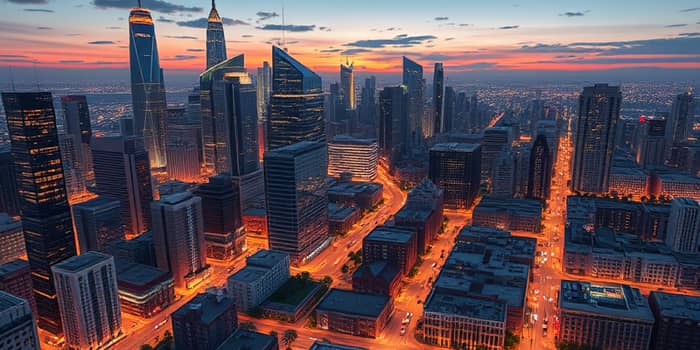
Urbanization is at the heart of a global transformation that touches every facet of modern life. As millions migrate to cities in search of opportunity and connection, real estate markets are experiencing unprecedented shifts. The steady rise in urban dwellers has profound implications for how we design, finance, and inhabit the spaces around us. Understanding these trends is crucial for investors, policymakers, developers, and communities seeking to navigate a future defined by crowded skylines and dynamic property values.
Over the next few decades, more than 6 billion people will call urban areas home. This shift will not only reshape housing demand, but also drive innovation in infrastructure, sustainability, and social equity. By examining current data, regional variations, and emerging challenges, we can uncover practical insights that empower stakeholders to make strategic, forward-looking decisions.
As of 2025, about 58% of the global population—nearly 4.8 billion people—reside in cities. Projections indicate that by 2035 this figure will climb to 5.6 billion, representing 62% of the world’s population. By mid-century, urban residents could reach 6.7 billion, or 68% of humanity. These numbers reflect not only natural population growth but also sustained rural-to-urban migration driven by economic opportunity and changing lifestyles.
The following table highlights the rapid pace of urban growth and the widening gap between urban and rural populations:
Asia currently hosts over half of the world’s urban residents, with China and India leading the wave. India alone will add roughly 416 million city residents by 2050, while China is expected to add 255 million. Africa, though only 43% urbanized today, is on the fastest trajectory—countries like Uganda, Tanzania, and the DRC register annual urban growth rates exceeding 4.5%. Meanwhile, North America and Europe already exceed 70% urbanization, focusing their expansion on redevelopment and densification.
These regional nuances create unique real estate dynamics. In Asia, the emphasis falls on large-scale new-build projects to meet soaring demand. African cities face the dual challenge of rapid growth and limited infrastructure, prompting innovative solutions that range from informal settlement upgrades to sustainable transit corridors. Mature markets in Europe and North America, by contrast, are reimagining urban cores through brownfield revitalization and adaptive reuse.
The urban boom fuels dramatic shifts in property types and locations. Residential demand is pivoting toward mixed-use developments and vertical construction that maximize land efficiency and foster walkable communities. Affordable housing remains a critical concern as land costs rise and construction expenses escalate. At the same time, luxury segments flourish in global cities where high-net-worth individuals seek exclusive amenities and prime locations.
On the commercial side, office and retail spaces are evolving in response to new work patterns and consumer behaviors. Logistics hubs, last-mile distribution centers, and flexible office solutions are emerging as key investment themes, particularly in rapidly urbanizing economies. However, oversupply risks persist in some mature markets affected by remote work trends, underscoring the importance of context-specific analysis.
Rapid urbanization often outpaces the capacity of cities to deliver essential services. With stressed urban infrastructure requiring investment, many municipalities confront gaps in transportation, water supply, and waste management. Balancing growth with environmental stewardship has become imperative to meet UN SDG 11 goals for sustainable cities and communities.
Social equity also comes to the fore as housing affordability crises deepen. Gentrification and displacement risk leaving lower-income residents behind as property values surge. Informal settlements expand without secure tenure, heightening vulnerabilities during climate-related events. These issues highlight the need for inclusive, resilient strategies that prioritize access to housing and public amenities.
Effective responses to urbanization’s challenges demand coordinated efforts across sectors. Policymakers can implement land-use regulations and incentives for smart city concepts and technology to drive efficient growth. Public-private partnerships unlock funding for affordable housing, transit expansion, and green infrastructure. Developers and investors should adopt data-driven site selection and design strategies that reflect evolving demographics.
Financial institutions have a role in supporting sustainable projects through green bonds, impact investing, and tailored financing structures that reward long-term social and environmental benefits. Community engagement must guide decision-making to ensure that new developments address local needs and preserve cultural heritage. Only by aligning economic, social, and environmental objectives can cities thrive amidst surging populations.
As urban populations approach unparalleled heights, real estate markets stand at a crossroads. The choices made today will reverberate for generations, shaping the fabric of our cities and the quality of life they deliver. By embracing innovation, sustainability, and equity, stakeholders can transform growth pressures into opportunities for vibrant, resilient, and inclusive urban futures.
Ultimately, urbanization trends are reshaping real estate demand in ways both profound and promising. Stakeholders who understand these dynamics and act proactively will be best positioned to unlock value, mitigate risks, and contribute to thriving communities around the globe.
References













